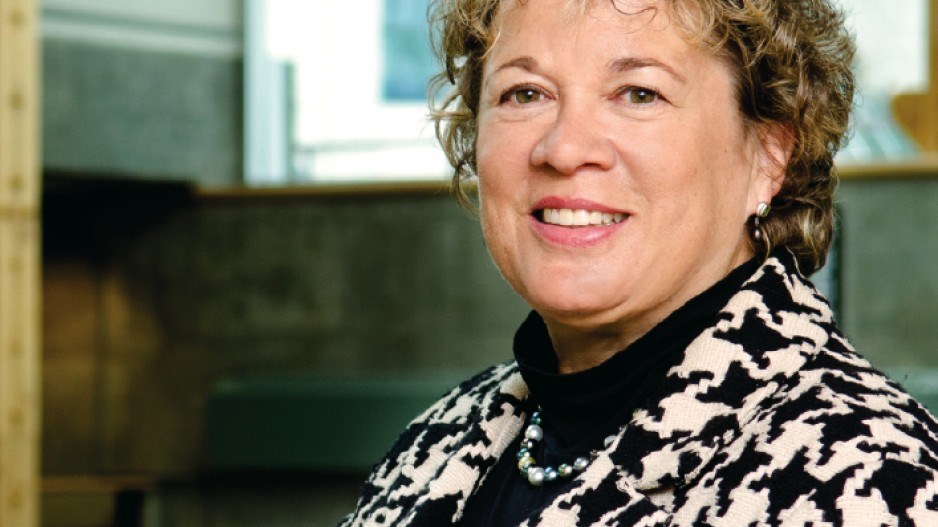Janet Holder, the woman tasked with getting the Northern Gateway pipeline built, had just landed in Kitimat June 13 when she began receiving urgent text messages from staff about an incident involving Greenpeace.
Campaigners with the environmental organization had shown up at the Vancouver office of Enbridge Inc. (TSX:ENB) with cameras and an oily piece of pipe and had managed to force their way into the company’s office.
It wasn’t the first confrontation the company has had with environmentalists over its $5.5 billion pipeline proposal, and it’s not likely to be the last.
Unlike natural gas pipelines needed to develop a liquid natural gas industry in B.C., Enbridge’s pipeline project – which would bring crude oil from the Alberta oilsands to the B.C. coast – is meeting considerable resistance, and not just from environmentalists.
B.C. NDP leader Adrian Dix has taken a stance again the project, and some First Nations organizations are opposing it, even though Enbridge claims 60% of First Nations in the pipeline corridor have signed equity agreements.
Enbridge has had no track record in B.C., as it does in the Prairie provinces, so a big part of Holder’s job will be building trust here.
“Enbridge doesn’t exist in British Columbia, so we don’t have any of that built-in goodwill,” Holder said.
“We’re having to build that in British Columbia.”
One of the reasons Holder was picked for the job was her B.C. roots. She was born and raised in Prince George, but Holder’s family left B.C. when she was 16. She has spent most of her career in Ontario and has been with Enbridge for 20 years. She joined the company after earning a BA in chemical engineering from the University of New Brunswick and an MBA from McMaster University. In her early 30s, shortly after being promoted to vice-president of gas supply, Holder was diagnosed with cancer and was forced to give up some of her responsibilities and work part-time.
“In reality what I discovered was I managed to do it all in half the time I used to do full-time,” she said. “I learned to delegate.”
Holder spent most of her career on the natural gas side of Enbridge’s business, but also spent 18 months in Edmonton working in the company’s crude oil unit.
Holder’s new job – executive vice-president of Western Access – has brought her back to Prince George, where she and her husband own an acreage. She also has an office in Vancouver.
Being back in B.C. will allow Holder to pursue some of her passions, which include skiing, snowshoeing and cutting her own firewood. Her husband, meanwhile, will pursue his passion – and vocation – which is restoring vintage cars and racecars. “It’s great because I get to drive all sorts of interesting vehicles.”
One other vehicle she drove recently was a bike – all the way from Vancouver to Seattle (240 kilometres). The journey was part of the Ride To Conquer Cancer, which Enbridge sponsors.
Holder was also part of the executive team given the task of finding someone to head up the Northern Gateway project. After narrowing candidates down to one, Holder realized she was the best candidate for the job.
“Somebody asked me, ‘Is this the right individual?’ I said, ‘There’s only one person who would be better. Me.’ My boss [CEO Pat Daniel] looked at me and said, ‘Would you do the job?’”
Jean Peverrett, former CEO of Union Gas, has known Holder for 15 years and thinks she has the right stuff for the job.
“Building pipelines is building pipelines,” said Peverrett. “What you’re talking about is trying to get the permission to do it, and it’s not easy building even gas pipelines in urban areas, which is something she spent a lot of time doing in Toronto.”
The 1,177-kilometre twin pipeline would carry up to 525,000 barrels of oil per day from the Alberta oilsands to Kitimat, and 193,000 barrels per day of condensate from Kitimat to the oilsands. Condensate is used to dilute the oilsands bitumen so it can be transported via pipeline.
A key to winning the project’s approval is getting the co-operation of First Nations in the pipeline corridor, and Holder insists that 60% of First Nations within a 180-kilometre swath have signed equity agreements that will give them a 10% stake in the pipeline.
Coastal First Nations executive director Art Sterritt disputes that claim, saying only two bands in the corridor have confirmed they have signed the agreement.
“Some of them, if you were to ask them whether they’ve signed, they will publicly say no,” Holder said. “They, frankly, will be bullied, potentially by other First Nations and by environmental groups. They are getting harassed. I can swear on a Bible that we do have equity agreements with 60% of the First Nations that are impacted by the potential route.” •




